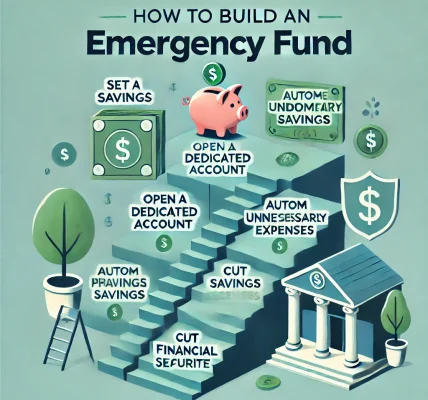Planning for retirement is crucial, but many people hesitate to save aggressively because they fear compromising their current lifestyle. The good news is that you can build a secure retirement fund while still enjoying life today. This guide explores practical, smart, and sustainable ways to save for retirement without sacrificing your present financial well-being.
Why Retirement Planning is Important
Retirement may seem far away, but the sooner you start saving, the more time your money has to grow. A well-structured retirement plan ensures:
- Financial independence in old age.
- The ability to maintain your desired lifestyle post-retirement.
- Protection against unexpected medical expenses.
- Reduced financial burden on family members.
1. Set Clear Retirement Goals
Before you start saving, determine how much you’ll need in retirement. Consider factors such as:
- Estimated retirement age.
- Expected monthly expenses.
- Inflation and rising costs.
- Healthcare expenses.
- Travel and leisure plans.
Using a retirement calculator can help you set realistic savings goals based on your future needs.
2. Start Early, Even with Small Contributions
The power of compound interest makes early investing highly effective. Even if you can only contribute a small amount, consistency is key.
- If you start saving at 25 with $200 per month at a 7% annual return, you could accumulate over $500,000 by retirement.
- If you wait until 40 to start, you would need to save nearly $600 per month to reach the same amount.
3. Maximize Employer-Sponsored Retirement Plans
If your employer offers a retirement savings plan, such as a 401(k), make sure you take full advantage of it.
- Employer Matching: Many companies match your contributions up to a certain percentage. Contributing enough to get the full match is essentially free money.
- Tax Benefits: Contributions to a 401(k) or similar plan reduce your taxable income, lowering your tax burden.
- Automatic Contributions: Set up automatic paycheck deductions to ensure consistent savings.
4. Diversify Your Investments
Relying solely on one type of investment can be risky. Diversifying your portfolio helps balance risk and maximize returns.
- Stocks: Higher growth potential, ideal for long-term retirement planning.
- Bonds: Lower risk, providing steady income.
- Real Estate: Can provide rental income and capital appreciation.
- Mutual Funds & ETFs: Professionally managed options that spread risk across various investments.
- IRAs (Individual Retirement Accounts): Tax-advantaged options that provide additional retirement savings benefits.
5. Reduce Unnecessary Expenses and Redirect Savings
Without cutting into essentials, identify areas where you can save money and redirect it toward retirement.
- Eat Out Less: Preparing meals at home can save thousands annually.
- Cancel Unused Subscriptions: Streaming services, gym memberships, and magazine subscriptions can add up.
- Use Cashback and Rewards Programs: Earn benefits on necessary purchases without overspending.
- Buy Second-Hand or Discounted: Clothing, electronics, and furniture often have great second-hand options.
Even redirecting $100 per month into your retirement account can make a significant difference over time.
6. Take Advantage of Tax-Advantaged Accounts
- Roth IRA: Contributions are made with after-tax income, but withdrawals in retirement are tax-free.
- Traditional IRA: Contributions reduce your taxable income now, though withdrawals in retirement are taxed.
- Health Savings Account (HSA): If eligible, an HSA can serve as a tax-free medical emergency fund for retirement.
7. Increase Savings with Salary Growth
Each time you receive a raise or bonus, allocate a portion of it toward retirement savings.
- If you receive a 5% salary increase, try to increase your retirement contributions by at least 1-2%.
- Avoid lifestyle inflation – instead of increasing expenses, increase your savings rate.
8. Consider Passive Income Streams
Having additional income sources can boost your retirement savings without cutting into your current lifestyle.
- Side Hustles: Freelancing, consulting, or an online business can generate extra income.
- Investments: Dividend stocks, rental properties, or REITs can provide passive income.
- Peer-to-Peer Lending: Alternative investments can offer additional earnings.
9. Avoid Common Retirement Savings Mistakes
- Not Saving at All: Waiting too long can severely impact retirement funds.
- Cashing Out Early: Withdrawing from retirement accounts before retirement can result in penalties and lost growth.
- Relying Solely on Social Security: Social Security benefits may not be enough to maintain your lifestyle.
- Ignoring Inflation: Failing to account for rising costs can reduce the value of your savings.
10. Review and Adjust Your Plan Regularly
Financial goals and life circumstances change. Review your retirement plan annually to:
- Adjust contributions based on income changes.
- Reallocate investments based on risk tolerance and market conditions.
- Ensure you’re on track to meet your retirement goals.
Final Thoughts
Saving for retirement doesn’t have to mean sacrificing your present lifestyle. By starting early, making smart financial choices, and optimizing available resources, you can secure your future while still enjoying today.
Take small steps now, remain consistent, and your future self will thank you!




